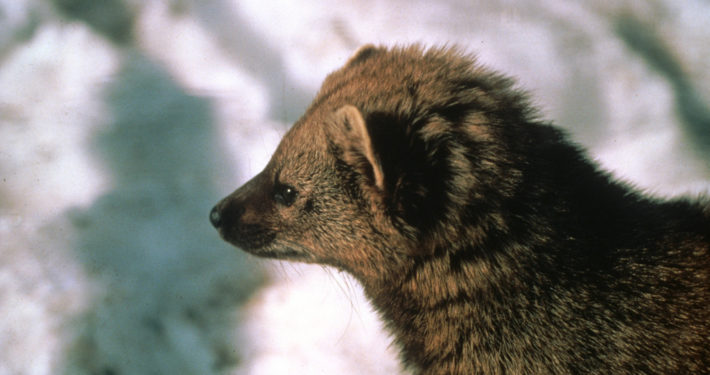Fisher
Description
The fisher is one of the largest members of the Mustelid or weasel family. The fisher (Martes pennanti) is the second largest member of the weasel family found in Massachusetts; only the river otter is larger. Although many people call them “fisher cats,” the name is inappropriate. They are neither members of the feline family, nor do they catch fish.
Except during their brief mating season, fishers are solitary creatures and are active during night and day throughout the year. (Source: MassAudubon)
Their preferred habitat is mixed forest with heavy canopy cover, as they tend to avoid traveling in large open areas. They commonly use hollow logs, stonewalls, tree cavities, and brush piles to rest.
Fishers are shy and elusive animals that are rarely seen even in areas where they are abundant. They can be active day or night. They tend to exhibit nocturnal and crepuscular (dawn and dusk) activity in the summer and diurnal (daytime) activity in the winter. They remain active year round and do not hibernate.
Diet: Fishers are omnivorous. Their primary foods include small rodents, squirrels, rabbits, birds, eggs, fruit, porcupines, and carrion. They will also opportunistically prey on poultry and domestic cats. Although they are proficient climbers, most of their hunting takes place on the ground. Fishers are one of the few mammals that prey on porcupines. Porcupines are difficult to kill, but a dead porcupine can provide many days of food for a fisher, so it is worth the effort. While on the ground, the fisher continually attacks the only vulnerable portions of the porcupine’s body, its face and underbelly. When facial wounds have weakened the porcupine, the fisher goes in for the kill. To avoid the quills, the fisher eats its prey starting at the head, neck, or underbelly.
Breeding & Reproduction: Fishers breed from February to March and exhibit a reproductive strategy called “delayed implantation.” The adult female breeds within days after giving birth, but the fertilized eggs remain dormant in her uterus for the next 10 –11 months. The fertilized eggs then implant in the uterine wall and begin normal development. The young are born 1–2 months after implantation. Females produce 1 litter each year consisting of 1–4 kits, with an average litter size of 3. The young are born helpless, blind, and sparsely furred. Maternal dens, typically located in a cavity high in a large tree, are used for the first 8–10 weeks. Once the kits become mobile, they are moved from the maternal den to one on or below the ground. It is believed that the maternal den protects the helpless young from aggressive male fishers and ground predators. The female nurses the kits until they reach four months of age. By five months of age, the kits are approximately the same size as the adult female and have begun to learn how to kill their own prey. The young remain with the female until late summer or early fall, at which time they disperse to begin their solitary lives as adults. They reach sexual maturity at one year of age, and females produce their first litter at the age of two.(source: Mass.gov)
canine distemper - contagious to unvaccinated domestic animals (Source: Integral Ecology Research Center)
Additional Info
DON’T LET FISHERS INTIMIDATE YOU: Don’t hesitate to scare or threaten fishers with loud noises, bright lights, or water sprayed from a hose.









